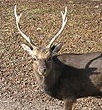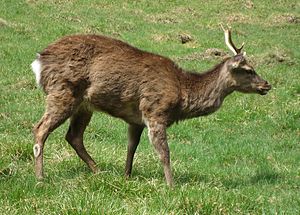The sika deer also known as the spotted deer or the Japanese deer, is a species of deer native to much of
East Asia, and introduced to various other parts of the world. Previously found from northern Vietnam in the
south to the Russian Far East in the north, it is now uncommon in these areas, excluding Japan, where the
species is overabundant.
Description
The sika deer is one of the few deer species that does not lose its spots upon reaching maturity. Spot
patterns vary with region. The mainland subspecies have larger and more obvious spots, in contrast to the
Taiwanese and Japanese subspecies, whose spots are nearly invisible. Many introduced populations are from
Japan, so also lack significant spots.
The color of the pelage ranges from mahogany to black, and white individuals are also known. During winter,
the coat becomes darker and shaggier and the spots less prominent, and a mane forms on the back of the males'
necks. They are medium-sized herbivores, though they show notable size variation across their several
subspecies and considerable sexual dimorphism, with males invariably much larger than females. They can vary
from 50 to 110 cm (20 to 43 in) tall at the shoulder and from 95 to 180 cm (37 to 71 in) in head-and-body
length. The tail measures about 7.5-13 cm (3.0-5.1 in) long.
The largest subspecies is the Manchurian sika deer (C. n. mantchuricus), in which males commonly weigh about
68-109 kg (150-240 lb) and females weigh 45-50 kg (99-110 lb), with large stags scaling up to 160 kg
(350 lb). On the other end of the size spectrum, in the Japanese sika deer (C. n. nippon), males weigh 40-70
kg (88-154 lb) and females weigh 30-40 kg (66-88 lb). All sikas are compact and dainty-legged, with short,
trim, wedge-shaped heads and a boisterous disposition. When alarmed, they will often display a distinctive
flared rump, much like the American elk.
Sika stags have stout, upright antlers with an extra buttress up from the brow tine and a very thick wall. A
forward-facing intermediate tine breaks the line to the top, which is usually forked. Occasionally, sika
antlers develop some palmation (flat areas). Females carry a pair of distinctive black bumps on the
forehead. Antlers can range from 28 to 45 centimetres (11 to 18 in) to more than 80 centimetres (30 in),
depending on the subspecies. Stags also have distinctive manes during the rut.
Behavior
The sika deer can be active throughout the day, though in areas with heavy human disturbance, they tend to be
nocturnal. Seasonal migration is known to occur in mountainous areas, such as Japan, with winter ranges
being up to 700 metres (2,300 ft) lower in elevation than summer ranges.
Lifestyles vary between individuals, with some occurring alone while others are found in single-sex groups.
Large herds will gather in autumn and winter. The sika deer is a highly vocal species, with over 10
individual sounds, ranging from soft whistles to loud screams.
Sika males are territorial and keep harems of females during the rut, which peaks from early September
through October, but may last well into the winter months. Territory size varies with habitat type and size
of the buck; strong, prime bucks may hold up to 2 hectares (5 acres). Territories are marked with a series
of shallow pits or "scrapes", into which the males urinate and from which emanates a strong, musky odor.
Fights between rival males are sometimes fierce and long, and may even be fatal.
In Nara Prefecture, Japan, the deer are also known as "bowing deer", as they bow their heads before being
fed special shika senbei. However, deer bow heads to signal that they are about to headbutt. Therefore,
when a human 'bows' to a deer, the deer will assume the same stance and may charge and injure the human.
Deer headbutt both for play and to assert dominance, as do goats. Sika deer are found throughout the city of
Nara and its many parks and temples like Todai-ji, as they are considered to be the messengers of the
Shinto gods.
Habitat
Sika deer are found in the temperate and subtropical forests of eastern Asia, preferring areas with dense
understory, and where snowfall does not exceed 10-20 cm (3.9-7.9 in). They tend to forage in patchy clearings
of forests. Introduced populations are found in areas with similar habitats to their native ranges,
including Western and Central Europe, Eastern United States, and New Zealand.
Diet
A sika deer's diet can include any of the following: marsh grasses, fallen leaves, trees, brushy vegetation,
herbs, fungi, bamboo, ground ferns, poison ivy, soy beans, and corn depending on environmental conditions
(Feldhamer 1980). In other words, these animals are highly adaptable and can be either grazers or browsers
in response to the situation at hand
Hunting
Across its original range and in many areas to which it has been introduced, the sika is regarded as a
particularly prized and elusive sportsman's quarry. In Britain, Ireland, and mainland Europe, sika display
very different survival strategies and escape tactics from the indigenous deer. They have a marked tendency
to use concealment in circumstances when red deer, for example, would flee, and have been seen to squat and
lie belly-flat when danger threatens.
Hunters and control cullers have estimated that the Sika's wariness and "cleverness" makes it three or four
times more difficult to bring to bag than a red or fallow deer. In the British Isles, sika are widely
regarded as a serious threat to new and established woodlands, and public and private forestry bodies adopt
policies of rigorous year-round culling.








